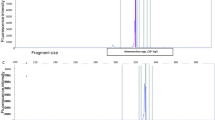Abstract
The glucose-6-phosphate dehydrogenase (G6PD, EC.1.1.1.49), glucose phosphate isomerase (GPI, EC.5.3.1.9), and malate dehydrogenase (MDH, EC.1.1.1.37) isoenzymatic patterns of Chabertia ovina were determined by starch-gel electrophoresis. The G6PD and GPI isoenzymatic patterns were characterized by the existence of three phenotypes: (1) a single and slow anodic band, (2) a single and fast anodic band, and (3) a large spot matching its migration with bands 1 and 2. These three phenotypes may be explained as the existence of only one gene locus for the G6PD and GPI in C. ovina. Allelic frequencies and the Hardy-Weinberg test were determined. This test indicated that the population was not in Hardy-Weinberg equilibrium. The MDH isoenzymatic pattern of C. ovina was characterized by the presence of two bands with anodic and cathodic migration. Furthermore, comparative isoenzyme studies were carried out between Oesophagostomum venulosum and C. ovina. The different G6PD, GPI, and MDH isoenzymatic patterns observed for the two species allowed us to distinguish them and, therefore, to use isoenzymatic patterns as a diagnostic tool to discriminate these species.
Similar content being viewed by others
Author information
Authors and Affiliations
Additional information
Received: 30 April 1999 / Accepted: 27 May 1999
Rights and permissions
About this article
Cite this article
Arias, P., Cutillas, C., Oliveros, R. et al. Characterization of Chabertia ovina by isoenzyme gel electrophoresis: comparative study with Oesophagostomum venulosum . Parasitol Res 85, 884–886 (1999). https://doi.org/10.1007/s004360050652
Issue Date:
DOI: https://doi.org/10.1007/s004360050652




